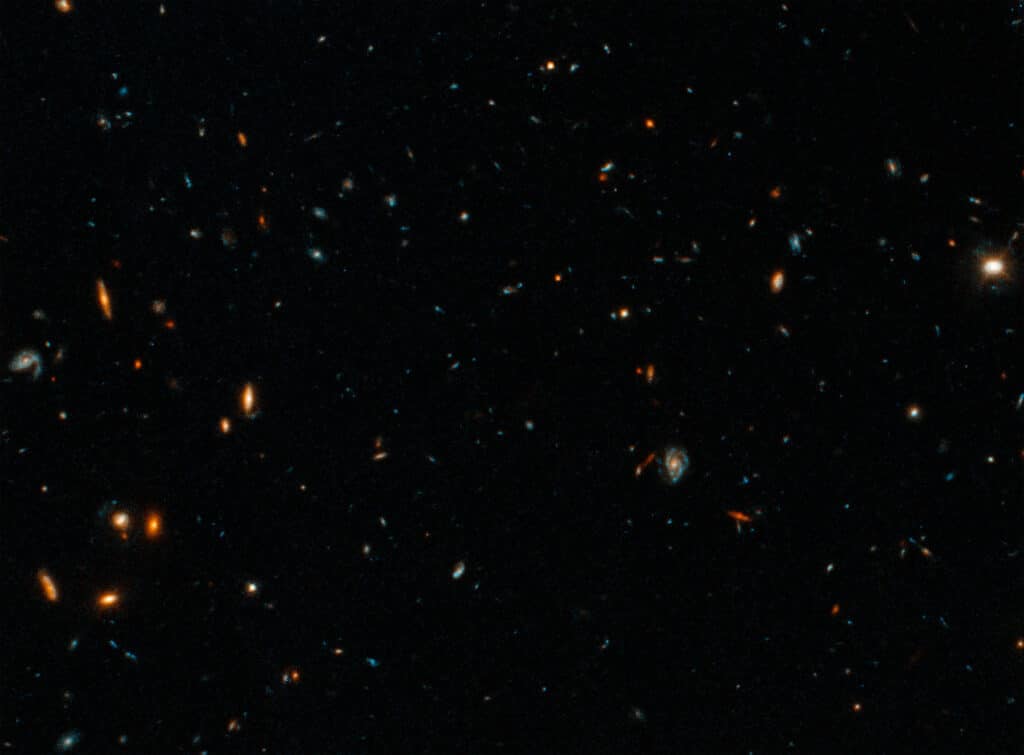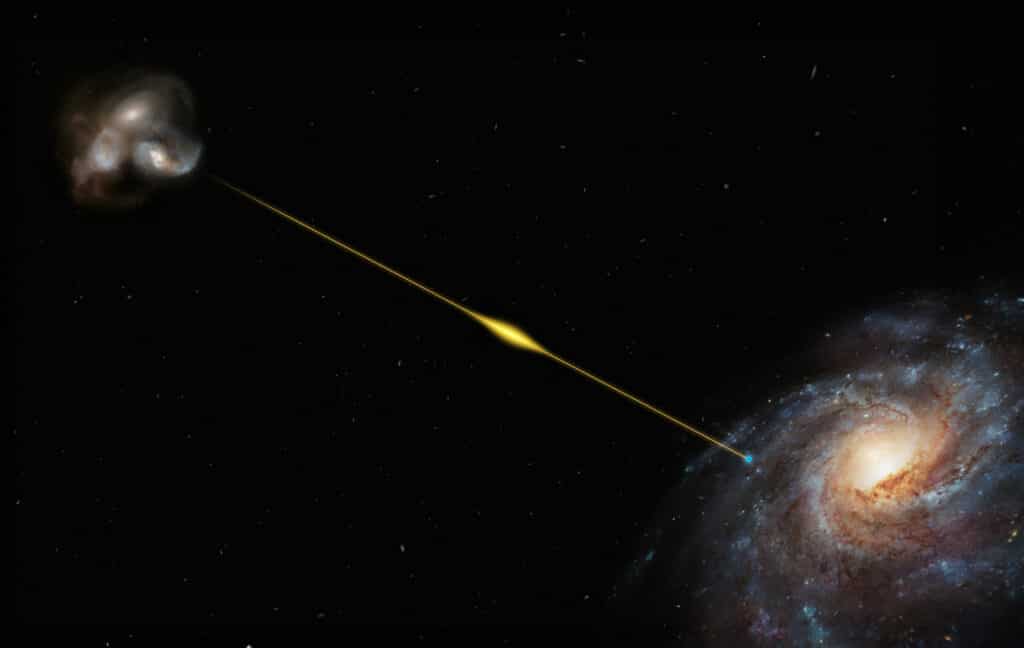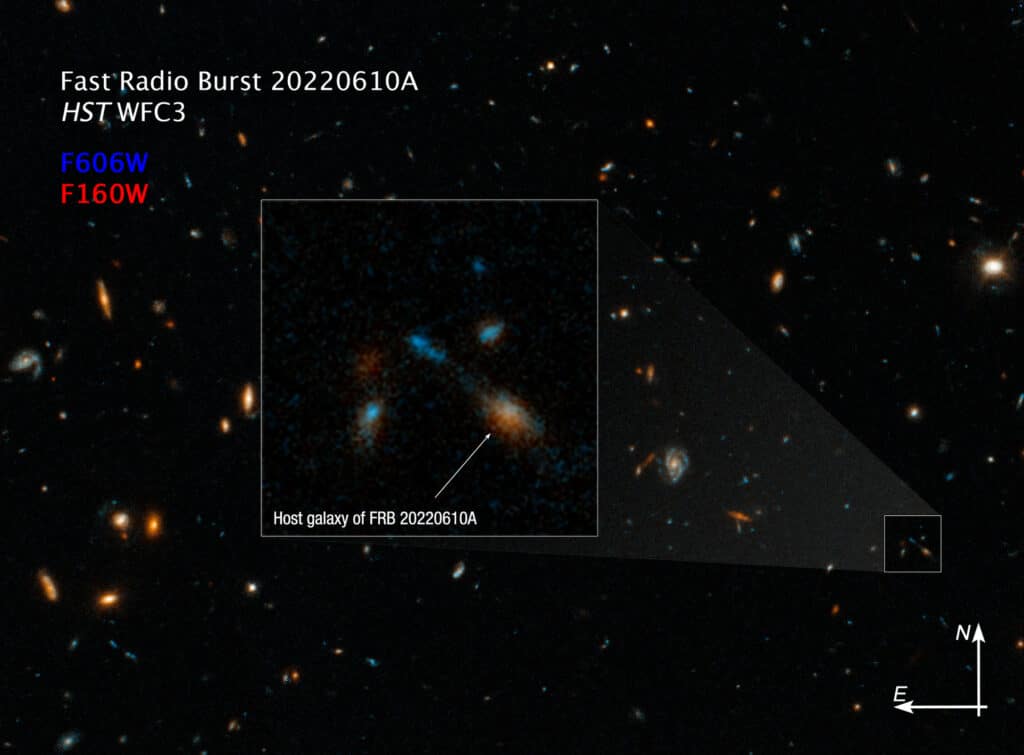Astronomers have traced the most powerful and distant fast radio burst (FRB) ever observed back to its “blob-like” origins. Remarkably, this FRB originated from a group of at least seven galaxies, potentially interacting with each other, rather than a single galaxy.
This finding, made possible by images from NASA’s Hubble Space Telescope, challenges current scientific models of how FRBs are produced. The research was led by scientists at Northwestern University.
Fast radio bursts are incredibly brief yet intense emissions of radio waves, each lasting only milliseconds but generating more energy than the sun does in a year. The FRB in question, labeled FRB 20220610A, stands out not only for its exceptional energy, which was four times greater than closer FRBs, but also for its significant distance. When this FRB was emitted, the universe was just 5 billion years old, compared to its current age of 13.8 billion years.

“Without the Hubble’s imaging, it would still remain a mystery as to whether this FRB originated from one monolithic galaxy or from some type of interacting system,” says study leader Alexa Gordon, graduate student in astronomy at Northwestern’s Weinberg College of Arts and Sciences, in a media release. “It’s these types of environments — these weird ones — that drive us toward a better understanding of the mystery of FRBs.”
Initially, astronomers thought the FRB emanated from a single, irregular galaxy or a cluster of three distant galaxies. However, Hubble’s detailed images suggest a much more complex scenario, with at least seven galaxies in extreme proximity, possibly on a path to merging.
“There are some signs that the group members are ‘interacting,'” says study co-author Wen-fai Fong, an associate professor of physics and astronomy at Northwestern. “In other words, they could be trading materials or possibly on a path to merging. These groups of galaxies (called compact groups) are incredibly rare environments in the universe and are the densest galaxy-scale structures we know of.”
This discovery of the FRB’s origin in a compact group of galaxies is significant because it could indicate a link between such rare galactic environments and the generation of FRBs.
“This interaction could trigger bursts of star formation,” explains Gordon. “That might indicate that the progenitor of FRB 20220610A is associated with a fairly recent population of stars which matches what we’ve learned from other FRBs.”

The nature of FRBs remains one of the most enigmatic subjects in astronomy. Since their discovery in 2007, about 1,000 FRBs have been detected, but their exact causes are still debated. Astronomers generally agree that they involve a compact object, like a black hole or neutron star, but a definitive explanation remains elusive.
“Despite hundreds of FRB events discovered to date, only a fraction of those have been pinpointed to their host galaxies,” notes study co-author Yuxin (Vic) Dong, a National Science Foundation graduate research, astronomy PhD student in Fong’s lab and member of CIERA. “Within that small fraction, only a few came from a dense galactic environment, but none have ever been seen in such a compact group. So, its birthplace is truly rare.”
The journey of these radio waves from distant galaxies to Earth is not just a marvel of distance; it’s a journey through time and space that interacts with material along the way. This interaction provides valuable information about the universe.
“Radio waves, in particular, are sensitive to any intervening material along the line of sight — from the FRB location to us,” says Fong. “That means the waves have to travel through any cloud of material around the FRB site, through its host galaxy, across the universe and finally through the Milky Way. From a time delay in the FRB signal itself, we can measure the sum of all of these contributions.”

The study of FRBs is not just about understanding these mysterious bursts themselves; it’s about gaining insights into the very fabric of the universe. As technology advances, astronomers anticipate detecting even fainter FRBs, further expanding our understanding of these cosmic phenomena.
Gordon is optimistic about the future of FRB research.
“In the near future, FRB experiments will increase their sensitivity, leading to an unprecedented rate in the number of FRBs detected at these distances,” concludes Gordon. “Astronomers will soon learn just how special the environment of this FRB was.”
The study was presented at the 243rd meeting of the American Astronomical Society in New Orleans.











